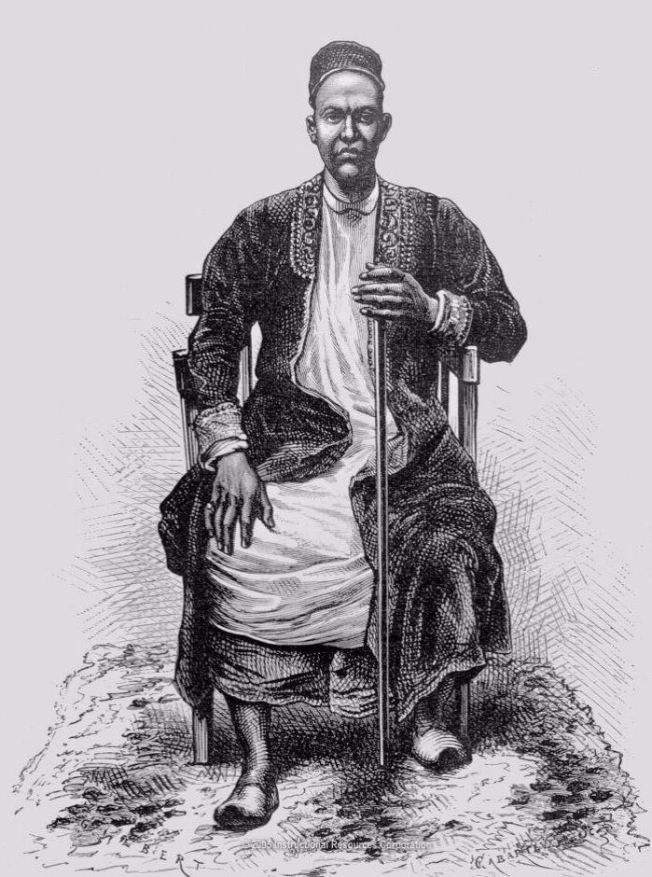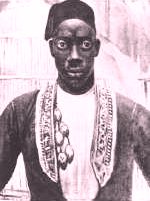 King Mutesa 1 of buganda
King Mutesa 1 of bugandaThe role of East African Societies in the Long Distance Trade
The most active societies in the development of the long distance trade in East Africa include, the Nyamwezi the Yao, the Kikuyu, Kamba, Baganda and Banyoro. It must also be noted that almost all communities participated in trade for the benefit of their people much as the mentioned tribes were the most dominant in East Africa.
It was not until the coming of European colonialists that the long distance trade declined in importance.
Role of the Baganda in Long Distance Trade
In the rise of the Kingdom of Buganda, we mentioned trade as one of the most important factors, which gave Buganda an honourable position among the interlacustrine states.
In 1844, the Arab merchants from the Coast touched the soil of Buganda. The rulers of Buganda continued to control the trading activities, and the Arabs were not warmly received.
 King Mutesa 1 of buganda
King Mutesa 1 of buganda
In 1856, Mutesa I became the new Kabaka of Buganda. Since there was rivalry between Buganda and Bunyoro. The Kabaka needed firearms to fight not only against the Banyoro but also the Egyptians. As a result, he accepted the Arabs and they, in turn, provided him with guns.
However, the Kabaka made it clear that the Coastal merchants could trade with Buganda only if they accepted trade conditions laid down by him.
The Baganda raided the neighbouring states such as Busoga, Bunyoro, Toro and Ankole for slaves and ivory. They even went into the islands and other areas to collect ivory from the people who in turn received food.
As a result of these trading activities, markets were established everywhere along the trade route junctions. A good example was Rabat at the Coast near Mombasa where the Chagga, Kamba, Taita, Swahili and other people met and traded with each other.
| Ssekabaka Muteesa I Mukaabya Walugembe Kayiira | |
|---|---|
| Kabaka of Buganda | |
 Mutesa I
|
|
| Reign | 1856 - 1884 |
| Predecessor | Suuna II of Buganda |
| Successor | Mwanga II of Buganda |
| Born | 1837 Mulago Hill |
| Died | 1884 (aged 47) Kasubi Nabulagala |
| Burial | Kasubi Nabulagala |
| Spouse | He married at least 85 wives |
| House | Abalasangeye dynasty |
| Father | Suuna II of Buganda |
| Mother | Abakyala Muganzirwazzaza |
Muteesa I Mukaabya Walugembe Kayiira was Kabaka of the Kingdom of Buganda, from 1856 until 1884. He was the thirtieth (30th) Kabaka of Buganda.
He was born at the Batandabezaala Palace, at Mulago in 1827. He was the son of Kabaka Ssuuna II Kalema Kasinjo, Kabaka of Buganda, who reigned between 1832 and 1856. His mother was Abakyala Muganzirwazzaza, the Namasole, one of the 148 recorded wives of his father. He ascended the throne upon the death of his father in October 1856. He was crowned at Nabulagala. He established his capital, first on Banda Hill. Later he abandoned that palace and established his capital at Kasubi, Nabulagala.[1]
Muteesa I Mukaabya Walugembe Kayiira is reported to have married 87 wives.[2]
He is reported to have fathered ninety-eight children, including:
A detailed list of all of Muteesa I's issue is contained at the following reference:[3]
Arab and Muslim traders from Zanzibar had been visiting Buganda since the 1840s to trade firearms, gunpowder, salt and cloth in exchange for ivory andslaves. During Kabaka Muteesa I's reign, these contacts continued.
At the same time, contact was made with European visitors for the first time in 1862 when John Speke and James Grant arrived. Their positive accounts attracted more visitors and Henry Stanley arrived in 1875.[4]:151
The Roman Catholics arrived in 1879, in the person of Father Simon Lourdel Monpel, popularly known as Pere Mapeera and Brother Amans, of the White Fathers.
All three visitor groups were made to believe that Kabaka Muteesa I preferred their religion over the others. They thus wrote favorable reviews back home to their respective governments, encouraging trade and friendly relations. As a result, Buganda, and Uganda were not colonized but were offered status of aprotectorate. The manner in which Muteesa I handled these three sets of visitors with competing interests is credited with the development that is enjoyed in the region today. He is credited as the most important of the kings of Buganda, because of his vision and diplomatic skills.[5]
He died at Kasubi Nabulagala on 9 October 1884 at the age of 47 years and was buried on 18 October 1884. He was buried at Kasubi, the first Kabaka to be buried there.[6] In 2007, Muteesa I Royal University was opened in his name, in recognition of his contribution to the education of the people of Buganda andUganda. The chancellor of the university is Kabaka Ronald Muwenda Mutebi II, the current reigning Buganda monarch.
| Preceded by Suuna II Kalema |
King of Buganda 1856 - 1884 |
Succeeded by Mwanga II Basammula Ekkere |
|
||||||